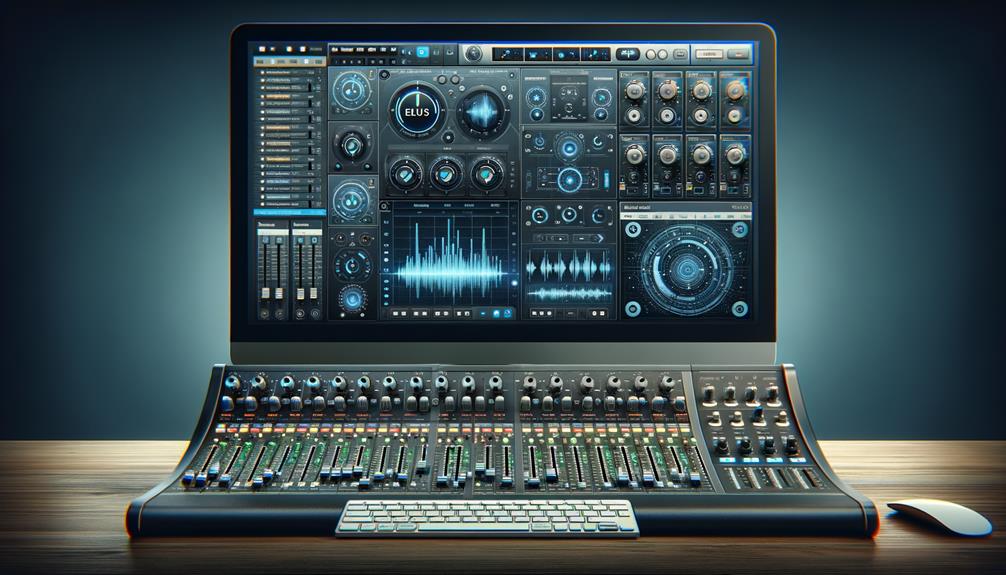To use Autotune in Logic Pro X, start by double-clicking your audio track and switching to “flex pitch.” Zoom in on the waveform and select the pitch correction dots to adjust them precisely. Next, input the vocal track’s key for accurate corrections. Fine-tune the timing by adjusting the time quantization settings, and listen closely to maintain a natural sound. Enhance your vocals with effects like reverb and monitor for pitch drift. Remember, exploring various settings can lead to ideal sound, and there’s much more to discover to improve your audio production!
Key Takeaways
- Open your audio track settings and switch to “flex pitch” using the hourglass icon to enable pitch correction functionality.
- Input the key of the vocal track into the pitch correction plugin for accurate tuning adjustments.
- Adjust individual pitch correction dots to the desired pitch level while ensuring a natural sound.
- Use time quantization settings to tighten timing alignment for a polished performance.
- Incorporate additional effects like reverb and save your progress regularly for optimal results.
Setting Up Autotune
When you’re ready to set up Autotune in Logic Pro X, it’s essential to plunge into the audio track settings by double-clicking the track you want to edit.
Once you’re in, you’re going to click on the hourglass icon to switch the audio setting from “flex time slicing” to “flex pitch.” This change is vital for effective pitch correction editing.
Zoom in on the audio waveform to pinpoint the pitch correction dots for precise adjustments. By selecting the appropriate pitch correction value, you can tailor the effect from the default zero to fit your needs. Additionally, remember to input the key of the vocal track into the pitch correction plugin for accurate tuning.
Finally, don’t forget to utilize gain adjustments to enhance audio levels, ensuring a balanced sound after the pitch corrections are applied.
Adjusting Pitch and Timing
After setting up Autotune, you can begin fine-tuning pitch and timing to enhance your audio track. Start by selecting individual pitch correction dots on the audio waveform. You’re going to double click on them and move them to the desired pitch level for precise note correction. For tighter timing, increase your time quantization settings, guaranteeing everything aligns with the intended rhythm. Adjust the pitch correction value from zero to meet your performance needs. Finally, don’t forget to utilize gain adjustments to maintain a balanced sound after applying corrections. Always listen to your adjustments to guarantee natural pitch and timing. Additionally, utilizing advanced pitch correction tools can significantly enhance the effectiveness of your adjustments.
| Adjustment Type | Action Taken |
|---|---|
| Pitch Correction | Double click and move dots |
| Timing Quantization | Increase settings |
| Pitch Correction Value | Modify from default |
| Gain Adjustments | Enhance overall levels |
| Quality Check | Listen through changes |
Additional Features
While exploring the additional features of Autotune in Logic Pro X, you’ll discover tools that can greatly improve your audio production.
You can add vocal effects like reverb, going beyond basic pitch correction to enrich your sound. The format shift feature adjusts tonal quality, giving you flexibility in sound design.
With pitch drift options, you’ll achieve nuanced corrections for sustained notes, resulting in a more natural sound. Highlighting the entire audio track allows for batch pitch correction, making it easier to apply uniform changes across multiple notes.
Additionally, using tools like GSnap plugin can further enhance your pitch correction capabilities. Remember, listening through adjustments during the process is essential to guarantee accuracy and maintain the integrity of your original performance.
These tools empower you to raise your mixes to a professional level.
Limitations to Consider
Although Autotune offers impressive capabilities for pitch correction, it comes with limitations that producers need to be aware of.
For instance, it may not always produce perfect results, leading to potential pitch inaccuracies in specific notes. When you’re adjusting pitches, incorrect tweaks can happen, especially deciding if a note should be raised or lowered.
After making adjustments, click play and listen closely; the automated corrections mightn’t align with your desired vocal quality.
In complex vocal performances, manual corrections are often necessary to achieve ideal sound. Additionally, understanding the key and scale settings is crucial for effective pitch correction and can help mitigate some of these issues.
Best Practices for Autotune
- Familiarize with the Interface: Know where the pitch correction settings are located to streamline your workflow.
- Experiment with Settings: Tweak different pitch correction values and time quantization to achieve the perfect sound for your performance.
- Save Regularly: Protect your progress by saving often, particularly after major changes or applying effects.
- Utilize Resources: Tap into online tutorials to discover advanced techniques that can sharpen your autotune skills.
- Explore Different Effects: Consider using a vocoder(#) alongside Autotune to create unique vocal textures and enhance your overall sound.
Frequently Asked Questions
How to Use Auto-Tune on Logic Pro X?
To use Auto-Tune in Logic Pro X for vocal processing, you’ll need to adjust pitch settings, edit individual notes, and apply enhancements like reverb. Always listen to your adjustments to guarantee the best sound quality.
How to Tune Vocals in Logic?
To tune vocals in Logic, you’ll employ vocal techniques like flex pitch for precise adjustments. Zoom in on the waveform, modify pitch correction dots, and analyze gain levels to achieve a polished, professional sound.
How Do You Use Auto-Tune?
To use Auto-Tune effectively, you’ll want to adjust pitch correction values and experiment with vocal effects like reverb. This enhances your sound while allowing for precise timing and tonal adjustments. Always listen closely for accuracy.
Does Logic Pro Have a Stock Auto-Tune?
Yes, Logic Pro has a stock pitch correction tool for vocal processing. It allows you to fine-tune pitch in real-time, offering an accessible way to achieve polished vocals without needing third-party autotune plugins.
Conclusion
Incorporating autotune into your Logic Pro X projects can raise your sound to professional levels. By mastering the setup, pitch adjustments, and additional features, you can achieve precise vocal tuning. While it’s essential to be aware of its limitations, employing best practices will help you maintain a natural feel in your music. Experiment, stay creative, and let autotune enhance your artistic vision without overshadowing your unique vocal identity. Immerse yourself and start transforming your tracks today!



